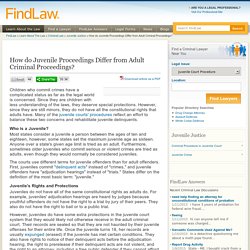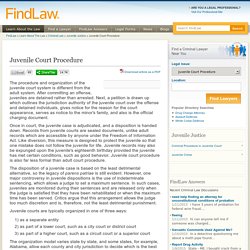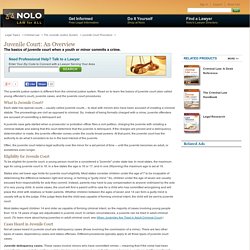

Juvenile justice research - National Institute of Justice Search Results. Hartinger-08.pdf. Juvenile vs. Adult Criminal System. Legal Topics > Criminal Law and Police > Juveniles > Juvenile Crime Authored by Ken LaMance, LegalMatch Law Library Managing Editor and Attorney at Law Locate a Local Criminal Lawyer How Does the Juvenile Criminal System Differ from the Adult Criminal System?

The criminal justice systems for adults and juveniles differ in many significant ways. There differences vary from state to state, but in general: Juveniles are not prosecuted for committing crimes, but rather delinquent acts. How do Juvenile Proceedings Differ from Adult Criminal Proceedings? Children who commit crimes have a complicated status as far as the legal world is concerned.

Since they are children with less understanding of the laws, they deserve special protections. However, since they are still minors, they do not have all the constitutional rights that adults have. Juvenile Court Procedure. The procedure and organization of the juvenile court system is different from the adult system.

After committing an offense, juveniles are detained rather than arrested. Next, a petition is drawn up which outlines the jurisdiction authority of the juvenile court over the offense and detained individuals, gives notice for the reason for the court appearance, serves as notice to the minor's family, and also is the official charging document. Once in court, the juvenile case is adjudicated, and a disposition is handed down. Records from juvenile courts are sealed documents, unlike adult records which are accessible by anyone under the Freedom of Information Act.
Just Cause Law Collective : Differences Between Juvenile and Adult Court. Constitutional Rights in Juvenile Cases. Minors in juvenile court delinquency proceedings do not have the same constitutional rights as those given to adults in regular criminal court cases.

In fact, prior to the 1960s juveniles had few due process rights at all. But as juvenile court proceedings have become more formal, states and courts have strengthened juveniles' constitutional rights. (To learn more about the unique nature of juvenile court cases, see Nolo's article Juvenile Court: An Overview.) Below is a summary of the due process rights that do and do not apply to juveniles in delinquency proceedings.
Some of these rights derive from U.S. Juvenile Court Case Process - Arrest, Referral, Detainment. The Office of Juvenile Justice and Delinquency Prevention (OJJDP) has published material charting the flow of a typical case through the juvenile court system.

As many cases are processed informally, and court decisions are highly individualized, the model "case flow" is rather general; however, the basic procedures described are standard nationwide. LawyerShop can help you find a criminal law attorney in your area today. Arrest, Referral, and Initial Detainment The first encounter a youth has with the juvenile justice system is usually his or her arrest by a law enforcement official. Other ways that youth enter the system include "referrals" by parents and schools, delinquency victims, and probation officers. When a juvenile court case reaches the juvenile probation department, an intake officer will decide whether to dismiss it, handle it informally, or hear it formally. Juvenile Delinquency: What Happens in a Juvenile Case?
When a juvenile is suspected of violating a criminal statute, the procedure that's followed is very different from that used for adult offenders in a typical criminal case.

All states have created a special juvenile court system for minors who get into trouble with the law. And although some minors are ultimately judged to be delinquent by these juvenile courts, the different players in a typical juvenile case -- including police officers, prosecutors, and judges -- have broad discretion to fashion other outcomes. (To learn about a minor's constitutional rights throughout the juvenile court process, see Nolo's article Constitutional Rights in Juvenile Cases.)
Although the procedure for juvenile delinquency cases varies from state to state, the following is a rundown of a typical juvenile case. (To learn about juvenile courts and delinquency in general, see Nolo's article Juvenile Courts: An Overview.) Constitutional Rights in Juvenile Cases. How The Juvenile Court Works. The Juvenile Division is responsible for the prosecution of all juvenile felony and misdemeanor offenses, excluding misdemeanor traffic offenses, for the Fifteenth Judicial Circuit.

The division makes all juvenile intake and filing decisions, including diversion, direct files to adult court and grand jury presentations. The Juvenile Division reviews approximately 600 cases per month for filing. An Assistant State Attorney is on call 24 hours each day to respond to questions from law enforcement officers and Department of Juvenile Justice employees regarding law and procedure. After a law enforcement officer takes a juvenile into custody for a violation of the law, they may either release the juvenile to the parent/guardian or to the Juvenile Assessment Center (JAC) where the detention process is initiated. If a juvenile is released to a parent/guardian, the officer sends the charges to the State Attorney’s Office for review.
Justice for Juvenile Lifers. January 2011. Lindsey, Ben B.: Judge Lindsey speaks to boys in his chamber, early 1900s. Lindsey, Ben B.: Judge Lindsey speaks to boys in his chamber, early 1900s.

Photograph. Britannica Online for Kids. Web. 13 Jan. 2015. < Ben B.: Judge Lindsey speaks to boys in his chamber, early 1900s. [Photograph]. In Britannica Online for Kids. While every effort has been made to follow citation style rules, there may be some discrepancies. Introduction to the Right to Counsel for Children in Juvenile Courts. You may be wondering how we’ve spent all of this time discussing the constitutional guarantee of counsel in criminal trials for anyone who cannot afford it, and not once have we even mentioned of the rights of children.

Well, that’s for very good reason. You see, under our state and federal laws, children are incapable of committing crimes. Instead, they commit “delinquent acts.” You could be forgiven if this seems like a distinction without a difference. Crime, Social Control, and Problems with Education. January 2011. Justice for Juvenile Lifers. Juvenile vs. Adult Criminal System.
Hartinger-08.pdf. Just Cause Law Collective : Differences Between Juvenile and Adult Court. Juvenile Court: An Overview. The juvenile justice system is different from the criminal justice system.

Read on to learn the basics of juvenile court (also called young offender's court), juvenile cases, and the juvenile court procedures. What Is Juvenile Court? Each state has special courts -- usually called juvenile courts -- to deal with minors who have been accused of violating a criminal statute. The proceedings are civil as opposed to criminal.
Loitering Law. Many states, cities and towns there are statutes or ordinances against loitering which aim to control aggressive begging, soliciting prostitution, drug dealing, blocking entries to stores, public drunkenness or being a public nuisance. Under such laws, the police can arrest someone who refuses to "move along. " These laws are sometimes the subject of controversy by critics who claim they are used to target disfavored groups in violation of their constitutional rights. Evading Arrest: Running From The Police. The crime of evading arrest is committed when a person flees (runs away) from a police officer to avoid being apprehended, detained, or arrested. Evading Arrest, Obstructing Justice, Resisting Arrest, and Resisting Arrest by Force Some states have specific laws against evading arrest on foot.
Other states have a general law that prohibits obstructing justice or resisting arrest, which includes running away from an officer (as well as other behavior). Evading arrest on foot (sometimes called flight) is committed by knowingly running away from an officer to escape capture, detention, or arrest. Juvenile Justice History — Center on Juvenile and Criminal Justice. This is an introduction to Juvenile Justice in America.
Since the 1990s, youth crime rates have plummeted. These falling crime rates have led many jurisdictions to rethink the punitive juvenile justice practices that became popular in the 1980s and 1990s. Today, states are instituting major systemic reforms designed to reduce institutional confinement, close old 19th century era reform schools, and expand community-based interventions. Teens Learn & Live the Law. What does due process mean? “Due process” means that a person has a right to be heard before a punishment or penalty is imposed. “Due process of law” means that citizens must be treated fairly by the government. A guarantee of due process is written into the U.S.
Constitution in the Fifth, Sixth, and Fourteenth Amendments. Introduction to the Right to Counsel for Children in Juvenile Courts. History of the Juvenile Justice System. Juvenile Justice in the United States From an historical perspective, the concept of having a separate legal framework for juvenile offenders is relatively new. Throughout history, children as young as 7 years old who were accused of wrongdoing were imprisoned with adults. In the early nineteenth century, the idea of reforming youth offenders took root in the United States. - The Future of Children -
Juvenile Law: Status Offenses. In juvenile cases, a "status offense" involves conduct that would not be a crime if it was committed by an adult -- in other words, the actions are considered to be a violation of the law only because of the youth's status as a minor (typically anyone under 18 years of age). Common examples of status offenses include underage drinking, skipping school, and violating a local curfew law. Juveniles and Age ("Status") Offenses.
Juvenile Delinquency Law. Juvenile Delinquent Law. Glossary. Criminal Resource Manual 38 "Juvenile" Defined. Crime legal definition of crime. Crime. Federal Bureau of Investigation - Uniform Crime Reporting (UCR) Program. Frequently Asked Questions (FAQs) General Information All textual references are to the UCR Handbook (pdf) (2004) unless otherwise noted. What is the UCR Program?
The UCR Program is a voluntary city, university and college, county, state, tribal, and federal law enforcement program that provides a nationwide view of crime based on the submission of statistics by law enforcement agencies throughout the country. When and how was the Program implemented? Juveniles Who Commit Sex Offenses Against Minors - 227763.pdf. 225344.pdf. Statistics: Reporting Systems and Methods - Unofficial Crime Statistics - Self, Victimization, Crimes, and Official.
Even though most of the fundamental problems with official crime statistics had been identified before the end of the nineteenth century, including the major problem of the dark figure of unknown crime, it was not until the mid-twentieth century that systematic attempts to unravel some of the mysteries of official statistics were initiated. Turning to data sources outside of the official agencies of criminal justice, unofficial crime statistics were generated in order to explore the dark figure of crime that did not become known to the police, to create measures of crime that were independent of the official registrars of crime and crime control, and to address more general validity and reliability issues in the measurement of crime.
There are two categories of unofficial data sources: social-science and private-agency records. The first of these is much more important and useful. Argosy University Campus Common - Home. Juvenile Offenders. Chapter3.pdf. Levitt Sample.qxd - 30579_1.pdf. Exploring%20Criminal%20Justice-Ch%203.pdf. Crime characteristics and trends. The National Crime Victimization Survey (NCVS) asks a series of screening questions of all household members to determine if they had any crime incidents. The household respondent, an adult household member with knowledge about the household, is asked about both personal and property crimes. Other household members are asked about personal crimes. If a respondent indicates that an incident(s) occurred, an incident form(s) is administered to obtained detailed information about the characteristics of each incident.
Neither victims nor interviewers classify crimes. Classification is based on the information provided on the incident form. Juvenile Arrest Rate Trends. Similar to the trends for other violent crimes, the juvenile arrest rate for aggravated assault reached a historic low in 2011. Easy Access to FBI Arrest Statistics. Race, Ethnicity, and Serious and Violent Juvenile Offending - 181202.pdf. Young Kids, Hard Time Director's Cut. When Juveniles Are Tried in Adult Criminal Court.
Trying Juveniles as Adults in Criminal Court: An Analysis of State Transfer Provisions. Community Responses to Juvenile Crime. The Future of Children - Home. Introduction. Reform Trends. Key Issues. Office of Justice Programs: Promising and Proven Programs on Youth Violence Prevention. Stats - Child Or Adult? - A Century Long View. Delinquency. Abstract - National Criminal Justice Reference Service. PoliceEncounterswithJuvenileSuspectsExplainingtheUseofAuthority.pdf.
Police: Handling of Juveniles – FREE Police: Handling of Juveniles information. Stats - Juvenile Vs Adult Justice. Microsoft Word - Carr rev PDF title TOC.doc - rep-rap.pdf. 30580_6.pdf. 01-Van Dijk (Crime)-45445.qxd - 38668_4.pdf. Delinquency (criminology) What Are the Social Process Theories in Juvenile Delinquency? Social Disorganization Theory. Difference in Social Structure and Social Process Theories. What Are the Social Process Theories in Juvenile Delinquency? Social Problems: Continuity and Change 1.0. 01-Van Dijk (Crime)-45445.qxd - 38668_4.pdf. Chapter 12: Social Control and Self-Control Theories. Chapter_01.pdf. Just Facts Fact Sheet March 2011.pdf. 04b-Thornberry(vol.4) - 04b.pdf. NR2006.pdf. JJSreportV13.pdf. From Both Sides Of The Bench - What Works?